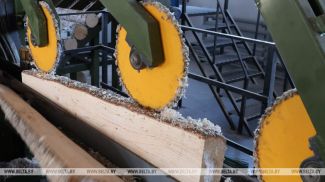
MINSK, 11 September (BelTA) – For many years Italy has been an example for Belarus in milk production and processing. It is important for us to show that Belarus is learning very quickly and has achieved decent results, BelTA learned from Director General of the applied science center of the National Academy of Sciences of Belarus on Food Aleksei Meleshchenya as he attended the second Belarusian-Italian round table on technologies for milk processing and dairy products manufacturing. The event took place at the National Academy of Sciences of Belarus on 10-13 September.
Belarus accounts for 6% of global milk export, making the country one of the world’s top ten exporters of dairy products. As Aleksei Meleshchenya emphasized, Italy remains a major importer of dairy products. "We hope to sell our products to Italy as well," the expert said.
In recent years the global dairy price growth rate has averaged 25%, which results in increased attention to the development of dairy products manufacturing. This is why Belarus prioritizes milk production and processing. Aleksei Meleshchenya emphasized the apparent success of this area.
Currently, Belarus ranks second in the world in condensed milk exports, third in butter and whey powder exports, fourth in cheese exports, and fifth in skimmed milk powder exports. "Belarus produces about 8 million tonnes of milk per year, while Italy produces around 14 million tonnes. We are still behind in terms of total volumes, but in terms of per capita we are confidently among the top ten, approaching 820 kilograms per person," Aleksei Meleshchenya added.
Over the past 30 years, Belarus has done a lot for the development of the dairy industry. Significant amounts of investment have been allocated for the construction and modernization of dairy farms, re-equipment and construction of new dairy industry enterprises. As elsewhere in the world, the local dairy plants are getting larger: Belarus had over 100 dairies about 25 years ago, but today it has 32 large dairy holdings.
"Belarus' self-sufficiency level in milk is almost 270%. By the way, Italy's own manufacturing of dairy products accounts for only about 80%," Aleksei Meleshchenya said. "In 2023 we sold our dairy products to 59 countries. In total we produce over 120,000 tonnes of butter, 260,000 tonnes of cheese, 130,000 tonnes of skimmed milk powder and over 130,000 tonnes of whey powder."
During the round table, experts in the dairy industry from Belarus and Italy discussed a wide range of topical matters. They included the prospects of Italy-Belarus trade relations, domestic specifics of milk and dairy products manufacturing, prospects of cooperation with Italian organizations, scientific support of the dairy industry in Belarus, scientists' research as a basis for the dairy industry innovative development, Belarus' cooling technologies, and many industry-related topics.
By the way, it is the second event focusing on cooperation with Italy. The first Belarusian-Italian round table on animal husbandry was held in Minsk on 28-29 February 2024. It was announced that Belarus and Italy intend to sign a communique on further cooperation following the two round tables.
Belarus accounts for 6% of global milk export, making the country one of the world’s top ten exporters of dairy products. As Aleksei Meleshchenya emphasized, Italy remains a major importer of dairy products. "We hope to sell our products to Italy as well," the expert said.
In recent years the global dairy price growth rate has averaged 25%, which results in increased attention to the development of dairy products manufacturing. This is why Belarus prioritizes milk production and processing. Aleksei Meleshchenya emphasized the apparent success of this area.
Currently, Belarus ranks second in the world in condensed milk exports, third in butter and whey powder exports, fourth in cheese exports, and fifth in skimmed milk powder exports. "Belarus produces about 8 million tonnes of milk per year, while Italy produces around 14 million tonnes. We are still behind in terms of total volumes, but in terms of per capita we are confidently among the top ten, approaching 820 kilograms per person," Aleksei Meleshchenya added.
Over the past 30 years, Belarus has done a lot for the development of the dairy industry. Significant amounts of investment have been allocated for the construction and modernization of dairy farms, re-equipment and construction of new dairy industry enterprises. As elsewhere in the world, the local dairy plants are getting larger: Belarus had over 100 dairies about 25 years ago, but today it has 32 large dairy holdings.
"Belarus' self-sufficiency level in milk is almost 270%. By the way, Italy's own manufacturing of dairy products accounts for only about 80%," Aleksei Meleshchenya said. "In 2023 we sold our dairy products to 59 countries. In total we produce over 120,000 tonnes of butter, 260,000 tonnes of cheese, 130,000 tonnes of skimmed milk powder and over 130,000 tonnes of whey powder."
During the round table, experts in the dairy industry from Belarus and Italy discussed a wide range of topical matters. They included the prospects of Italy-Belarus trade relations, domestic specifics of milk and dairy products manufacturing, prospects of cooperation with Italian organizations, scientific support of the dairy industry in Belarus, scientists' research as a basis for the dairy industry innovative development, Belarus' cooling technologies, and many industry-related topics.
By the way, it is the second event focusing on cooperation with Italy. The first Belarusian-Italian round table on animal husbandry was held in Minsk on 28-29 February 2024. It was announced that Belarus and Italy intend to sign a communique on further cooperation following the two round tables.













